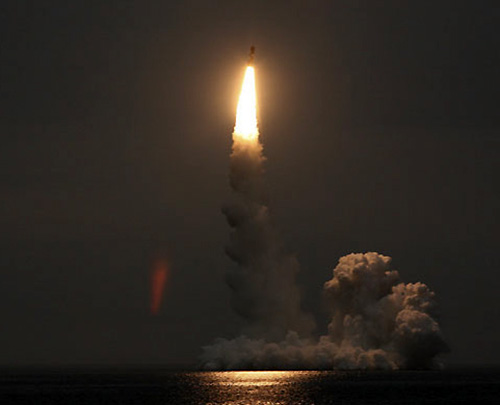The Northern Fleet is on the move. This is what the Russian Defense Ministry officially announces, which has issued several navigation restrictions for civilian ships. The off-limits area is the eastern Barents Sea, west of the southern island of Novaya Zemlya. The navigation ban issued by the Russian port authorities is effective from today and will remain in force until next Saturday, October XNUMXst. We will almost certainly see multiple missile launches Bulava.
Northern Fleet command confirms the presence of the battlecruiser Pyotr Velikiy, of the destroyer Admiral Ushakov and a class submarine Oscar II. In total, the Russians have twelve warships and ten support units in operation in the Barents Sea. The class submarine would already be in launch position Borei "Yury Dolgoruky", who left Severodvinsk on Sunday morning.
Last April, the Russian Admiralty confirmed the launch of sixteen ICBMs by 2016 (Bulava, Topol-M, yars e Sarmat). A multiple launch of ICBMs is also planned. The multiple launches will have to demonstrate the reliability of the submarines, which will have to be able to fire in motion, at a depth of 50 meters and in rough seas.
Multiple launches are a rare occurrence, although the Russians hold a particular record. On 6 August 1991 the class submarine Delta IV "Novomoskovsk" (K-407) made history for having launched, with an interval of a few seconds, 16 ballistic missiles (RSM-54) with a total weight of almost 700 tons. The operation Behemoth-2 has demonstrated the ability to launch, in the event of a possible nuclear scenario, the entire salvo of strategic missiles from the depths of the sea, therefore from a safe position. The United States record belongs to the nuclear submarine leader of the class Ohio, which launched four missiles Trident-2.
It is not yet clear how many Bulava they will launch the Russians, but after the delays and problems with the development of the missiles, Putin could order a total launch.
 Fourth generation class submarines Borei they will form the backbone of the Russian Navy's strategic nuclear deterrent. They will replace the class submarines Typhoon, Delta-3 e Delta-4. Within the 2020, the Russian Navy plans to operate a total of eight class ballistic submarines Borei: three 955 and five 955-A. Considering the structural changes, it would not be a mistake to define the 955-A submarines as a class Borei-II.
Fourth generation class submarines Borei they will form the backbone of the Russian Navy's strategic nuclear deterrent. They will replace the class submarines Typhoon, Delta-3 e Delta-4. Within the 2020, the Russian Navy plans to operate a total of eight class ballistic submarines Borei: three 955 and five 955-A. Considering the structural changes, it would not be a mistake to define the 955-A submarines as a class Borei-II.
To date, the entire class cannot yet enter deterrent service because it does not have the equipment to carry it out. Every Borei should carry sixteen to twenty missiles Bulava (955A only), each equipped with six to ten Mirv warheads. The Russians are optimistic about missiles Bulava and class submarines Borei, which is entrusted with nuclear deterrence at least until the 2050 (after the abandonment of the studies on the R-39UTTH missile Bark).
The three-stage missile Bulava, codename Nato SS-N-30 Mace, is the naval version of the most advanced Russian ballistic missile, the SS-27 Topol-M. It can also be launched in motion. It carries up to 10 Mirv warheads, can hit targets up to eight thousand kilometers away and is designed to exclusively equip class nuclear submarines Borei (changes on Typhoon were deemed too expensive).
Despite numerous failures due to manufacturing defects, the Russian Defense argues that there is no alternative to Bulava. Due to the failure during the tests of the new intercontinental missiles Bulava, the Borei they are not yet able to carry out their primary task, namely nuclear deterrence.
Each Bulava (12,1 meters long, 2,1 meters in diameter and 36,8 tons heavy) is armed with 6-10 thermonuclear warheads for 96-196 submarine warheads. The possible coverage of sensitive targets, considering the range of eight thousand kilometers, could be the Barents Sea and the Sea of Okhotsk. If the Russians launched from these areas, they could hit anywhere in the continental United States. The Borei will carry out strategic patrols along the southern latitudes to cover possible targets.
The last missile Bulava was launched almost a year ago.
(photo: MoD Russian Federation)












